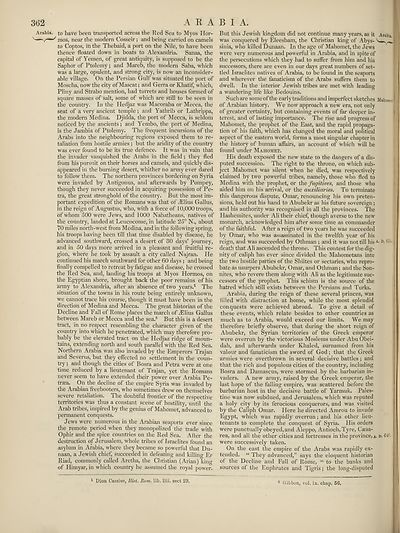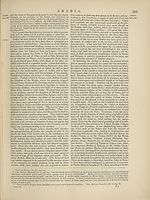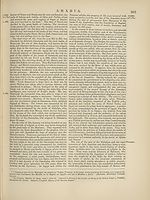Encyclopaedia Britannica > Volume 3, Anatomy-Astronomy
(370) Page 362
Download files
Complete book:
Individual page:
Thumbnail gallery: Grid view | List view

362 A R A
Arabia, to have been transported across the Red Sea to Myos Hor-
v''—mos, near the modern Cosseir; and being carried on camels
to Coptos, in the Thebaid, a port on the Nile, to have been
thence floated down in boats to Alexandria. Sanaa, the
capital of Yemen, of great antiquity, is supposed to be the
Saphor of Ptolemy; and Mareb, the modern Saba, which
was a large, opulent, and strong city, is now an inconsider¬
able village. On the Persian Gulf was situated the port of
Moscha, now the city of Muscat; and Gerra or Khatif, which,
Pliny and Strabo mention, had turrets and houses formed of
square masses of salt, some of which are still to be seen in
the country. In the Hedjaz was Macoraba or Mecca, the
seat of a very ancient temple; and Yathrib or Lathrippa,
the modern Medina. Djidda, the port of Mecca, is seldom
noticed by the ancients; and Yembo, the port of Medina,
is the Jambia of Ptolemy. The frequent incursions of the
Arabs into the neighbouring regions exposed them to re¬
taliation from hostile armies ; but the aridity of the country
was ever found to be its true defence. It was in vain that
the invader vanquished the Arabs in the field; they fled
from his pursuit on their horses and camels, and quickly dis¬
appeared in the burning desert, whither no army ever dared
to follow them. The northern provinces bordering on Syria
were invaded by Antigonus, and afterwards by Pompey,
though they never succeeded in acquiring possession of Pe¬
tra, the great stronghold of the country. But the most im¬
portant expedition of the Romans was that of dElius Gallus,
in the reign of Augustus, who, with a force of 10,000 troops,
of whom 500 were Jews, and 1000 Nabatheans, natives of
the country, landed at Leucocome, in latitude 25° N., about
70 miles north-west from Medina, and in the following spring,
his troops having been till that time disabled by disease, he
advanced southward, crossed a desert of 30 days’ journey,
and in 50 days more arrived in a pleasant and fruitful re¬
gion, where he took by assault a city called Najran. He
continued his march southward for other 60 days; and being
finally compelled to retreat by fatigue and disease, he crossed
the Red Sea, and, landing his troops at Myos Hormos, on
the Egyptian shore, brought back the poor remains of his
army to Alexandria, after an absence of two years.1 The
situation of the towns in his route being entirely unknown,
we cannot trace his course, though it must have been in the
direction of Medina and Mecca. The great historian of the
Decline and Fall of Rome places the march of iElius Gallus
between Mareb or Mecca and the sea.2 But this is a desert
tract, in no respect resembling the character given of the
country into which he penetrated, which may therefore pro¬
bably be the elevated tract on the Hedjaz ridge of moun¬
tains, extending north and south parallel with the Red Sea.
Northern Arabia was also invaded by the Emperors Trajan
and Severus, but they effected no settlement in the coun¬
try ; and though the cities of Bosra and Petra were at one
time reduced by a lieutenant of Trajan, yet the Romans
never seem to have extended their power over Arabia Pe-
traea. On the decline of the empire Syria was invaded by
the Arabian freebooters, who sometimes drew on themselves
severe retaliation. The doubtful frontier of the respective
territories was thus a constant scene of hostility, until the
Arab tribes, inspired by the genius of Mahomet, advanced to
permanent conquests.
Jews were numerous in the Arabian seaports ever since
the remote period when they monopolized the trade with
Ophir and the spice countries on the Red Sea. After the
destruction of Jerusalem, whole tribes of Israelites found an
asylum in Arabia, where they became so powerful that Du-
naan, a Jewish chief, succeeded in defeating and killing Er
Riad, commonly called Aretha, the Christian (Arian) king
of Himyar, in which country he assumed the royal power.
B I A.
But this Jewish kingdom did not continue many years, as it Arabia
was conquered by Eleesbam, the Christian king of Abys-
sinia, who killed Dunaan. In the age of Mahomet, the Jews
were very numerous and powerful in Arabia, and in spite of
the persecutions which they had to suffer from him and his
successors, there are even in our days great numbers of set¬
tled Israelites natives of Arabia, to be found in the seaports
and wherever the fanaticism of the Arabs suffers them to
dwell. In the interior Jewish tribes are met with leading
a wandering life like Bedouins.
Such are some of the early traditions and imperfect sketches Mahomet]
of Arabian history. We now approach a new era, not only
of greater certainty, but containing events of far deeper in¬
terest, and of lasting importance. The rise and progress of
Mahomet, the prophet of the East, and the rapid propaga¬
tion of his faith, which has changed the moral and political
aspect of the eastern world, forms a most singular chapter in
the history of human affairs, an account of which will be
found under Mahomet.
His death exposed the new state to the dangers of a dis¬
puted succession. The right to the throne, on which sub¬
ject Mahomet was silent when he died, was respectively
claimed by two powerful tribes, namely, those who fled to
Medina with the prophet, or the fugitives, and those who
aided him on his arrival, or the auxiliaries. To terminate
this dangerous dispute, Omar, renouncing his own preten¬
sions, held out his hand to Abubekr as his future sovereign ;
and his authority was recognised in all the provinces. The
Hashemites, under Ali their chief, though averse to the new
monarch, acknowledged him after some time as commander
of the faithful. After a reign of two years he was succeeded
by Omar, who was assassinated in the twelfth year of his
reign, and was succeeded by Othman ; and it was not till hisA- D> 63J'
death that Ali ascended the throne. This contest for the dig¬
nity of caliph has ever since divided the Mahometans into
the two hostile parties of the Shiites or sectaries, who repro¬
bate as usurpers Abubekr, Omar, and Othman; and the Son-
nites, who revere them along with Ali as the legitimate suc¬
cessors of the prophet. This schism is the source of the
hatred which still exists between the Persians and Turks.
Arabia, during the reign of these several princes, was
filled with distraction at home, while the most splendid
conquests were achieved abroad. To give a detail of
these events, which relate besides to other countries as
much as to Arabia, would exceed our limits. We may
therefore briefly observe, that during the short reign of
Abubekr, the Syrian territories of the Greek emperor
were overrun by the victorious Moslems under Abu Obei-
dah, and afterwards under Khaled, surnamed from his
valour and fanaticism the sword of God; that the Greek
armies w ere overthrown in several decisive battles; and
that the rich and populous cities of the country, including
Bosra and Damascus, were stormed by the barbarian in¬
vaders. A new army, raised by the Greek emperor, the
last hope of the falling empire, was scattered before the
barbarian host in the decisive battle of Yarmuk. Pales¬
tine was now subdued, and Jerusalem, which was reputed
a holy city by its ferocious conquerors, and was visited
by the Caliph Omar. Here he directed Amrou to invade
Egypt, which was rapidly overrun; and his other lieu¬
tenants to complete the conquest of Syria. His orders
were punctually obeyed, and Aleppo, Antioch, Tyre, Caesa¬
rea, and all the other cities and fortresses in the province, a. d. 040. j
were successively taken.
On the east the empire of the Arabs was rapidly ex¬
tended. “ They advanced,” says the eloquent historian
of the Decline and Fall of Rome, “ to the banks and
sources of the Euphrates and Tigris; the long-disputed
1 Dion Cassius, Hist. Rom. lib. liii. sect 29.
2 Gibbon, vol. ix. chap. 56.
Arabia, to have been transported across the Red Sea to Myos Hor-
v''—mos, near the modern Cosseir; and being carried on camels
to Coptos, in the Thebaid, a port on the Nile, to have been
thence floated down in boats to Alexandria. Sanaa, the
capital of Yemen, of great antiquity, is supposed to be the
Saphor of Ptolemy; and Mareb, the modern Saba, which
was a large, opulent, and strong city, is now an inconsider¬
able village. On the Persian Gulf was situated the port of
Moscha, now the city of Muscat; and Gerra or Khatif, which,
Pliny and Strabo mention, had turrets and houses formed of
square masses of salt, some of which are still to be seen in
the country. In the Hedjaz was Macoraba or Mecca, the
seat of a very ancient temple; and Yathrib or Lathrippa,
the modern Medina. Djidda, the port of Mecca, is seldom
noticed by the ancients; and Yembo, the port of Medina,
is the Jambia of Ptolemy. The frequent incursions of the
Arabs into the neighbouring regions exposed them to re¬
taliation from hostile armies ; but the aridity of the country
was ever found to be its true defence. It was in vain that
the invader vanquished the Arabs in the field; they fled
from his pursuit on their horses and camels, and quickly dis¬
appeared in the burning desert, whither no army ever dared
to follow them. The northern provinces bordering on Syria
were invaded by Antigonus, and afterwards by Pompey,
though they never succeeded in acquiring possession of Pe¬
tra, the great stronghold of the country. But the most im¬
portant expedition of the Romans was that of dElius Gallus,
in the reign of Augustus, who, with a force of 10,000 troops,
of whom 500 were Jews, and 1000 Nabatheans, natives of
the country, landed at Leucocome, in latitude 25° N., about
70 miles north-west from Medina, and in the following spring,
his troops having been till that time disabled by disease, he
advanced southward, crossed a desert of 30 days’ journey,
and in 50 days more arrived in a pleasant and fruitful re¬
gion, where he took by assault a city called Najran. He
continued his march southward for other 60 days; and being
finally compelled to retreat by fatigue and disease, he crossed
the Red Sea, and, landing his troops at Myos Hormos, on
the Egyptian shore, brought back the poor remains of his
army to Alexandria, after an absence of two years.1 The
situation of the towns in his route being entirely unknown,
we cannot trace his course, though it must have been in the
direction of Medina and Mecca. The great historian of the
Decline and Fall of Rome places the march of iElius Gallus
between Mareb or Mecca and the sea.2 But this is a desert
tract, in no respect resembling the character given of the
country into which he penetrated, which may therefore pro¬
bably be the elevated tract on the Hedjaz ridge of moun¬
tains, extending north and south parallel with the Red Sea.
Northern Arabia was also invaded by the Emperors Trajan
and Severus, but they effected no settlement in the coun¬
try ; and though the cities of Bosra and Petra were at one
time reduced by a lieutenant of Trajan, yet the Romans
never seem to have extended their power over Arabia Pe-
traea. On the decline of the empire Syria was invaded by
the Arabian freebooters, who sometimes drew on themselves
severe retaliation. The doubtful frontier of the respective
territories was thus a constant scene of hostility, until the
Arab tribes, inspired by the genius of Mahomet, advanced to
permanent conquests.
Jews were numerous in the Arabian seaports ever since
the remote period when they monopolized the trade with
Ophir and the spice countries on the Red Sea. After the
destruction of Jerusalem, whole tribes of Israelites found an
asylum in Arabia, where they became so powerful that Du-
naan, a Jewish chief, succeeded in defeating and killing Er
Riad, commonly called Aretha, the Christian (Arian) king
of Himyar, in which country he assumed the royal power.
B I A.
But this Jewish kingdom did not continue many years, as it Arabia
was conquered by Eleesbam, the Christian king of Abys-
sinia, who killed Dunaan. In the age of Mahomet, the Jews
were very numerous and powerful in Arabia, and in spite of
the persecutions which they had to suffer from him and his
successors, there are even in our days great numbers of set¬
tled Israelites natives of Arabia, to be found in the seaports
and wherever the fanaticism of the Arabs suffers them to
dwell. In the interior Jewish tribes are met with leading
a wandering life like Bedouins.
Such are some of the early traditions and imperfect sketches Mahomet]
of Arabian history. We now approach a new era, not only
of greater certainty, but containing events of far deeper in¬
terest, and of lasting importance. The rise and progress of
Mahomet, the prophet of the East, and the rapid propaga¬
tion of his faith, which has changed the moral and political
aspect of the eastern world, forms a most singular chapter in
the history of human affairs, an account of which will be
found under Mahomet.
His death exposed the new state to the dangers of a dis¬
puted succession. The right to the throne, on which sub¬
ject Mahomet was silent when he died, was respectively
claimed by two powerful tribes, namely, those who fled to
Medina with the prophet, or the fugitives, and those who
aided him on his arrival, or the auxiliaries. To terminate
this dangerous dispute, Omar, renouncing his own preten¬
sions, held out his hand to Abubekr as his future sovereign ;
and his authority was recognised in all the provinces. The
Hashemites, under Ali their chief, though averse to the new
monarch, acknowledged him after some time as commander
of the faithful. After a reign of two years he was succeeded
by Omar, who was assassinated in the twelfth year of his
reign, and was succeeded by Othman ; and it was not till hisA- D> 63J'
death that Ali ascended the throne. This contest for the dig¬
nity of caliph has ever since divided the Mahometans into
the two hostile parties of the Shiites or sectaries, who repro¬
bate as usurpers Abubekr, Omar, and Othman; and the Son-
nites, who revere them along with Ali as the legitimate suc¬
cessors of the prophet. This schism is the source of the
hatred which still exists between the Persians and Turks.
Arabia, during the reign of these several princes, was
filled with distraction at home, while the most splendid
conquests were achieved abroad. To give a detail of
these events, which relate besides to other countries as
much as to Arabia, would exceed our limits. We may
therefore briefly observe, that during the short reign of
Abubekr, the Syrian territories of the Greek emperor
were overrun by the victorious Moslems under Abu Obei-
dah, and afterwards under Khaled, surnamed from his
valour and fanaticism the sword of God; that the Greek
armies w ere overthrown in several decisive battles; and
that the rich and populous cities of the country, including
Bosra and Damascus, were stormed by the barbarian in¬
vaders. A new army, raised by the Greek emperor, the
last hope of the falling empire, was scattered before the
barbarian host in the decisive battle of Yarmuk. Pales¬
tine was now subdued, and Jerusalem, which was reputed
a holy city by its ferocious conquerors, and was visited
by the Caliph Omar. Here he directed Amrou to invade
Egypt, which was rapidly overrun; and his other lieu¬
tenants to complete the conquest of Syria. His orders
were punctually obeyed, and Aleppo, Antioch, Tyre, Caesa¬
rea, and all the other cities and fortresses in the province, a. d. 040. j
were successively taken.
On the east the empire of the Arabs was rapidly ex¬
tended. “ They advanced,” says the eloquent historian
of the Decline and Fall of Rome, “ to the banks and
sources of the Euphrates and Tigris; the long-disputed
1 Dion Cassius, Hist. Rom. lib. liii. sect 29.
2 Gibbon, vol. ix. chap. 56.
Set display mode to:
![]() Universal Viewer |
Universal Viewer | ![]() Mirador |
Large image | Transcription
Mirador |
Large image | Transcription
Images and transcriptions on this page, including medium image downloads, may be used under the Creative Commons Attribution 4.0 International Licence unless otherwise stated. ![]()
| Encyclopaedia Britannica > Encyclopaedia Britannica > Volume 3, Anatomy-Astronomy > (370) Page 362 |
|---|
| Permanent URL | https://digital.nls.uk/193762158 |
|---|
| Attribution and copyright: |
|
|---|---|
| Shelfmark | EB.16 |
|---|---|
| Description | Ten editions of 'Encyclopaedia Britannica', issued from 1768-1903, in 231 volumes. Originally issued in 100 weekly parts (3 volumes) between 1768 and 1771 by publishers: Colin Macfarquhar and Andrew Bell (Edinburgh); editor: William Smellie: engraver: Andrew Bell. Expanded editions in the 19th century featured more volumes and contributions from leading experts in their fields. Managed and published in Edinburgh up to the 9th edition (25 volumes, from 1875-1889); the 10th edition (1902-1903) re-issued the 9th edition, with 11 supplementary volumes. |
|---|---|
| Additional NLS resources: |
|

